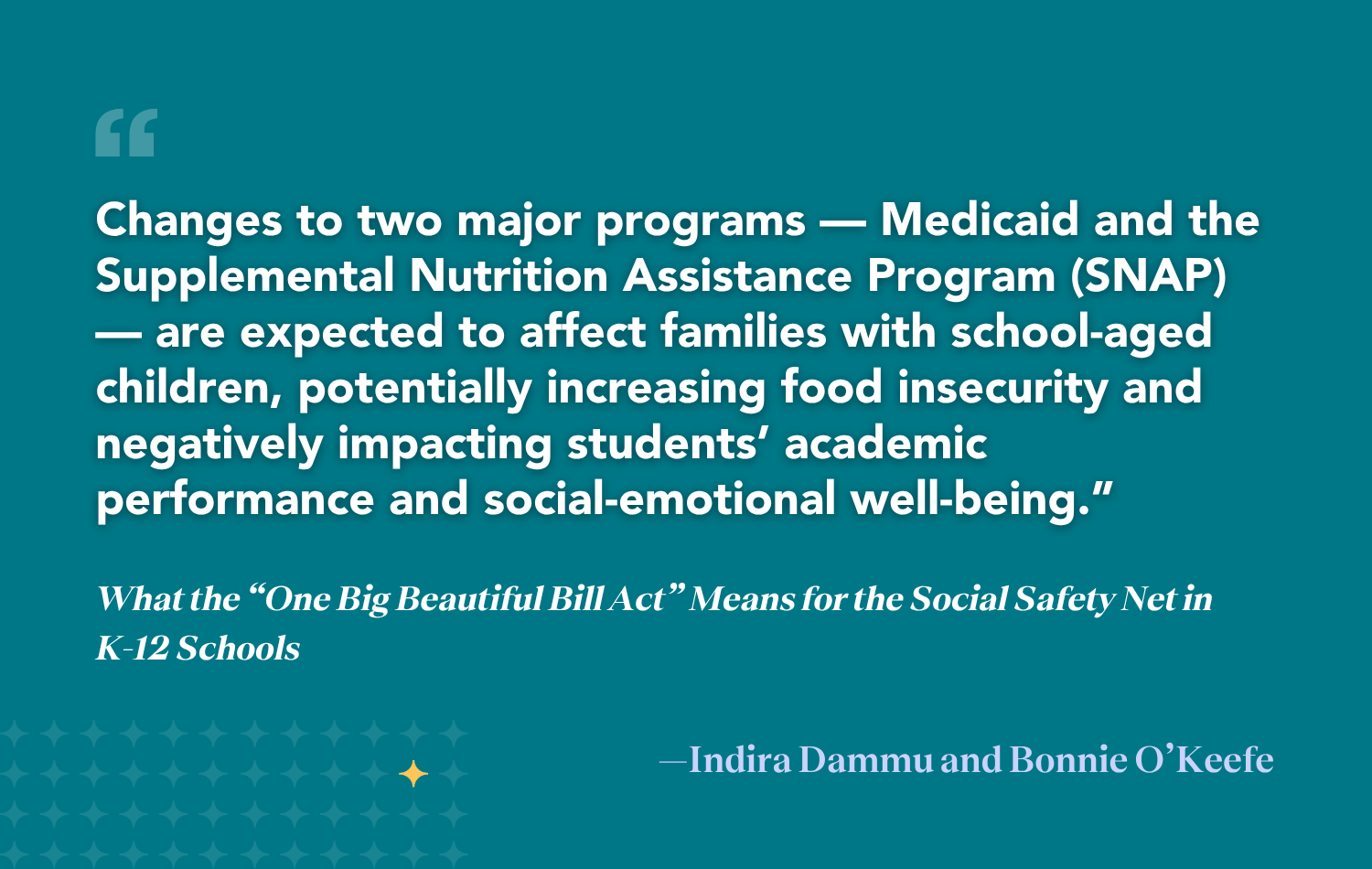Click here to read our longer analysis on federal changes to the social safety net and an overview of actions that state policymakers can take in advance of these changes.
On July 4, 2025, after months of debate by federal lawmakers, President Trump signed the 2025 Budget Reconciliation Bill (H.R. 1) into law. Nicknamed the “One Big Beautiful Bill Act,” the sweeping legislative package will reshape the American social safety net, which has historically served as a lifeline for millions of low-income Americans, including children. Changes to two major social safety net programs — Medicaid and the Supplemental Nutrition Assistance Program (SNAP) — are expected to affect families with school-aged children, potentially increasing food insecurity and negatively impacting students’ academic performance and social-emotional well-being.
Students Who Lose Medicaid Coverage Will Suffer in School
About 71.4 million people in the U.S. are enrolled in Medicaid; approximately 30 million of them (42%) are children. Starting in 2027, most adults ages 19 to 64 who are enrolled in Medicaid will need to meet work reporting requirements to maintain their health care coverage under the new law. As part of this requirement, most adults must work or participate in qualifying activities such as community service for at least 80 hours per month. While parents and caregivers with children under the age of 13 will be exempt from these requirements, those with older children could lose coverage due to these new rules, and their children’s access to health care would also be at risk.
Medicaid also reimburses school districts for the costs associated with providing health care services to Medicaid-eligible children. Medicaid is the fourth-largest federal funding source for K-12 public schools, providing more than $7.5 billion in funding for school-based health services. Schools may not feel the brunt of federal Medicaid cuts right away since most states’ school-based Medicaid programs are “carved out” from traditional Medicaid (i.e., school districts are directly reimbursed by state Medicaid agencies). However, there are five states (California, Minnesota, South Carolina, Tennessee, and Washington) where school-based Medicaid services are part of managed care contracts; in these states, managed care organizations reimburse districts directly. That could put these states at a higher risk of losing funding for school-based Medicaid programs.
In all states, fewer students will be eligible for Medicaid under the new law, the consequences of which will be devastating for their educational outcomes and well-being. There is a considerable body of research on the overlap between health care access and academic performance. For example, students with chronic health conditions are more likely to miss school and perform worse academically than students without these conditions. Students with chronic health conditions are also more likely to be chronically absent — and more likely to drop out of school. On the other hand, children who are Medicaid-eligible have positive outcomes that extend long past their coverage: They are more likely to graduate from college and have increased earnings in adulthood than those who were not eligible for Medicaid.
SNAP Cuts Will Likely Increase Food Insecurity for Students
H.R. 1 also makes significant changes to SNAP eligibility, a program that provides money for food to economically disadvantaged families. In fiscal year 2022, children ages 5 to 17 accounted for about 28% of SNAP participants across the country. Work requirements would now apply to more adults participating in SNAP under the new law, including those with children ages 14 and up. That could mean fewer families would qualify for food assistance, even families with children in school.
The new law also requires states to begin contributing 5% to 15% of SNAP benefits based on a measure known as the “payment error rate.” Previously, the federal government paid 100% of the cost of benefits; with these added expenses for states — including higher shares of administrative costs — some state policymakers might scale back their SNAP programs to save money. As a result, households with children on SNAP would lose access to nutritious food. Research shows that hungry students don’t learn as well as fed ones, making the likelihood of SNAP cuts detrimental to the learning outcomes of students whose families rely on government assistance to feed them.
Loss of Automatic Eligibility Could Lead to Reduced School Funding
States use Medicaid and SNAP enrollment to automatically qualify students for free school meals through a process called “direct certification.” Early analysis by the Urban Institute has found that around 800,000 students could lose automatic eligibility and would need to apply for the programs manually in the future. Some states also use direct certification counts to identify students from low-income households for additional state funding — meaning the new eligibility restrictions could lower these counts and lead to reduced funding for schools unless states revise their funding formulas or adopt new methods to measure student poverty.
Over the coming weeks and months, Bellwether will continue monitoring federal changes to Medicaid and SNAP under this new law and the impact on students and schools.
